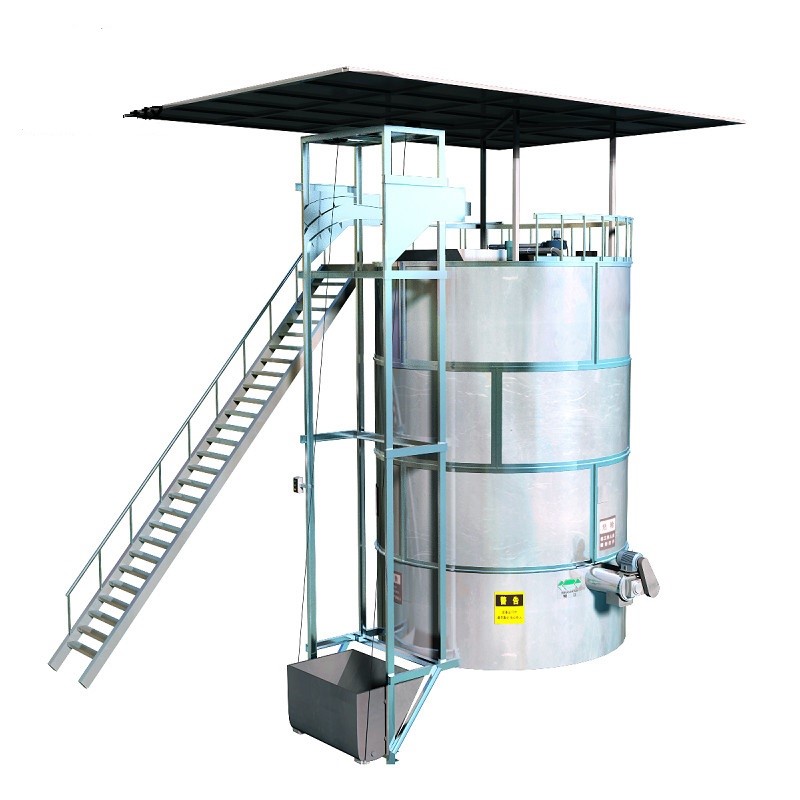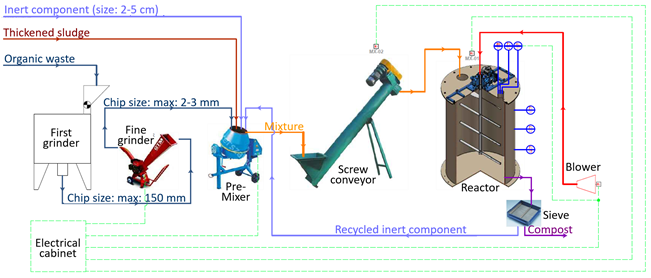
Unique selling points
- Compost-based eco-engineered media
- Free of enteric pathogens
- Rapid composting: 5-times faster than conventional composting
Description of the technology
Rapid composting can be applied for the treatment of excess sludge together with pruning waste. This technology can be combined with a sewer mining unit containing a membrane bioreactor, in which the excess sludge is produced.
Prior to the rapid composting, the excess sludge is thickened until it reaches a dry solids content of approximately 5%. The wood and green waste is shredded, homogenised and sorted – to get a 2-5 mm fraction by sieving in a pre-treatment step. In a mixing unit, the homogenised wood and green waste is mixed with the thickened excess sludge and an inert filling material consisting of shredded wood of 2-5 cm size. Approximately 700 L/per week are incubated in the rapid composting unit – an in-vessel composting system - at mostly aerobic conditions due to continuous air supply by the connected blower. Here, at a temperature between 50 °C and 70 °C, aerobic microorganisms convert approximately 20% to 30% of the volatile organic material to CO2 and water (Metcalf et al. 2013) and thus, stabilise the material.
The output is a compost-based growing media product with output rate of around 150 -180 kg per week. The output compost goes through a sieve to get back the inert filling material. It should be noted, the heavy metals and trace organics in the excess sludge and in the finished product must be monitored in order to ensure a concentration which complies with the regulations for the use of the end product. If the composting is properly conducted, it is possible to kill all pathogens, weeds and seeds during the composting process.
Flow scheme of the technology

Synergetic effects and motivation for the implementation of the technology
- Recovery of carbon and nutrients from excess sludge and pruning waste
Besides the stabilized carbon compounds, also nutrients originating from the excess sludge such as nitrogen and phosphorus are recovered though the compost-based product.
- Enteric pathogens are destroyed during composting
Due to the high temperature (50°C - 70 °C) in the composting process, the resulting growing media is expected to be free of enteric pathogens (Metcalf et al. 2013).
- No disposal of sludge and pruning waste
Instead of disposing the excess sludge and the pruning waste, a new product can be generated and thus, disposal costs can be saved as well as costs for a conventional fertilizer, since that is substituted by the new product.
Technology requirements and operating conditions
The excess sludge has to be thickened prior to the rapid composting. Its dry solids (DS) content should be at least 5% - but based on the process assessment this value may be revised. The ratio between the wood and green waste to the thickened excess sludge should be evaluated on experiment before the start-up. The process is operated at a temperature of up to 70°C and the retention time in the composting unit ranges between 10 and 20 days.
|
Parameter |
Units |
Min |
Max |
Reference |
|
Dry solids (DS) content of excess sludge |
% |
5 |
- |
Biopolus 2020 |
|
Ratio of green/wood waste to thickened excess sludge |
- |
1:1 |
1:2 |
NextGen D1.5 (in prep.) |
|
Temperature during high rate conversion of volatile compounds |
°C |
50 |
70 |
|
|
Oxygen content in gas output of composting unit |
% |
5 |
10 |
Biopolus 2020 |
|
pH for optimum aerobic decomposition |
- |
7 |
7.5 |
|
|
Volatile solids of composting mix |
% |
30 |
- |
|
|
Moisture content of composting mix |
% |
40 |
50 |
Biopolus 2020 |
|
Solid material retention time |
d |
10 |
20 |
Biopolus 2020 |
Key performance indicators
The compost-based growing material is usually an odour nuisance free and a humus-like material. The humus-like material content ranges between 70-85 %, while its nitrogen and phosphorus content greatly depend on the input material characteristics.
|
Parameter |
Units |
Min |
Max |
References |
|
Nitrogen content |
% |
2 |
3 |
Biopolus 2020 |
|
Phosphorus content |
% |
0,5 |
1 |
Biopolus 2020 |
|
Humus-like material content |
% |
70 |
85 |
|
|
Particle size of the product |
mm |
2 |
5 |
Links to related topics and similar reference projects
|
Processes/ technologies |
Reference |
|
Rapid composting unit |
|
|
Biopolus 2020 |
Small scale pilot project in Taiwan |
Case Study applying the technology
Publications
- Kleyböcker, A., Kenyeres, I., Poor-Pocsi, E., Nättorp, A., Loreggian, L., Schaub, M., Egli, C., Grozavescu, M., Murariu, M., Radu, B., Scheer, P., Lindeboom, R., Giurgiu, R., Suters, R., Heinze, J., Soares, A., Vale, P., Kim, J., Lanham, A., Hofman, J., D1.5 (2022) New approaches and best practices for closing materials cycle in the water sector, 2022
- Metcalf & Eddy, Inc., Tchobanoglous, G., Stensel, H., Tsuchihashi, R. Burton, F., Wastewater Engineering: Treatment and Resource Recovery, 2013

